Rwanda Battles First Marburg Virus Outbreak: A Public Health Emergency
Is the Marburg Virus Outbreak in Rwanda a sign of a growing threat? The recent emergence of the Marburg virus in Rwanda marks the first outbreak in the country's history. This alarming development highlights the urgent need for swift action to contain the spread and protect public health.
Editor Note: Rwanda's Marburg virus outbreak has been officially confirmed on [Insert Date]. The virus is a highly contagious and deadly disease, making it a public health emergency.
The outbreak has raised significant concerns about the potential for widespread transmission. This article explores the Marburg virus, its symptoms, transmission, treatment, and prevention strategies implemented by the Rwandan government.
Analysis: This article analyzes the current situation in Rwanda, examining the challenges and responses in the face of the Marburg virus. It also provides insights into the global implications of this outbreak, highlighting the need for greater preparedness and collaboration.
Key Aspects of the Marburg Virus Outbreak in Rwanda:
| Key Aspect | Description |
|---|---|
| Virus | The Marburg virus is a highly contagious and deadly hemorrhagic fever virus, a close relative of the Ebola virus. |
| Symptoms | Symptoms of Marburg virus disease include fever, headache, muscle aches, and bleeding. |
| Transmission | The virus spreads through direct contact with infected bodily fluids, including blood, vomit, feces, and urine. |
| Treatment | There is currently no specific treatment for Marburg virus disease; however, supportive care, including fluid replacement, can improve outcomes. |
| Prevention | Prevention measures include avoiding contact with infected individuals and animals, proper hygiene practices, and safe handling of infected materials. |
| Rwandan Response | The Rwandan government has implemented a robust public health response, including isolation of suspected cases, contact tracing, and community awareness. |
Marburg Virus: A Deadly Threat
The Marburg virus, a member of the Filoviridae family, causes severe illness, characterized by high fever, severe headache, muscle aches, and bleeding. It is highly contagious and spreads through direct contact with infected bodily fluids, including blood, vomit, feces, and urine.
The virus poses a significant threat to public health due to its high fatality rate, which can range from 24% to 88% depending on the specific outbreak. While there is currently no specific treatment available, supportive care, including fluid replacement, is crucial for managing symptoms.
Understanding the Current Situation in Rwanda
The outbreak in Rwanda presents a significant public health challenge. The country has a limited healthcare infrastructure, and the outbreak may overwhelm the existing resources. The government has implemented a multi-pronged strategy to contain the spread of the virus. This strategy involves several key aspects:
1. Surveillance and Case Detection: The Ministry of Health has implemented stringent surveillance measures to identify suspected cases, using rapid diagnostic tests and laboratory confirmation.
2. Contact Tracing: Public health officials are actively identifying and monitoring individuals who have come into contact with infected patients, implementing rigorous quarantine protocols and health monitoring.
3. Public Awareness and Education: Extensive public awareness campaigns have been launched to educate the public about the virus, its symptoms, and prevention measures.
4. Infection Control Measures: Healthcare workers are equipped with personal protective equipment (PPE) and are trained in infection control protocols to minimize the risk of transmission.
5. International Collaboration: The Rwandan government has sought technical assistance and support from international organizations like the World Health Organization (WHO) and the Centers for Disease Control and Prevention (CDC).
Conclusion:
The Marburg virus outbreak in Rwanda highlights the need for continued vigilance and a robust public health response to infectious diseases. While the virus poses a significant threat, early detection, prompt treatment, and comprehensive public health measures can help control the outbreak.
International collaboration is essential to support Rwanda's efforts to contain the outbreak and prevent further spread. It is crucial to strengthen public health infrastructure, implement effective surveillance systems, and develop new treatments and vaccines to combat this deadly virus.

